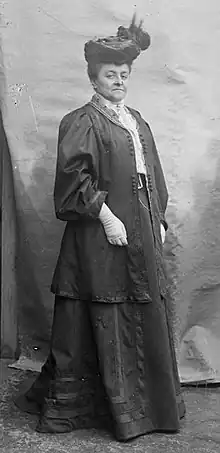Henriette Delamarre de Monchaux | |
|---|---|
 Henriette Delamarre de Monchaux in 1908 | |
| Born | 11 October 1854 Paris, France |
| Died | 12 May 1911 Paris, France |
| Other names | Countess Pierre Lecointre |
| Occupation(s) | Naturalist, geologist and paleontologist |
| Known for | Falun deposit research |
| Spouse | Roman Count Pierre Lecointre |
| Children | 3 |
Henriette Delamarre de Monchaux, née Valentine Henriette Huberte Delamarre de Monchaux (11 October 1854 – 12 May 1911), was a French naturalist, geologist and paleontologist.[1] She was a pioneer in the latter two disciplines, becoming a specialist in a type of marine deposit. Her works, notably Les Faluns de La Touraine, also support the theory of evolution. She was also a militant feminist. In 1875, she married Pierre Lecointre, a Roman Count. She signed several of her articles Countess Pierre Lecointre, and she is still sometimes identified by that surname.
Biography
Henriette Delamarre de Monchaux was the daughter of Théodore Didier Delamarre, a painter, and Mathilde Lyautey. She was the granddaughter of General Hubert Joseph Lyautey and Théodore-Casimir Delamarre, a banker and politician, respectively.
Education
Henriette Delamarre de Monchaux married Roman Count Pierre Lecointre (born 1841) on 25 August 1875 and took the name Countess Lecointre.[1] Her husband was a member of several learned societies, including the Archaeological Society of Touraine and the Geographical Society of Paris. The couple lived at Château of Grillemont, in the Chapelle-Blanche-Saint-Martin commune (Indre-et-Loire).[2] Both expressed a strong attachment to Roman Catholicism and royalism; she became president of the Royalist Ladies of Touraine. The couple had three children.[3]
The Countess developed an interest in a wide range of subjects, including regionalism through Touraine folklore, and became a committed suffragist. She also developed a scientific interest in geology and paleontology.
Research on falun deposits
.jpg.webp)
From the 1890s onwards, Countess Lecointre built up a large collection of Miocene fossils and conducted studies on the Touraine cliffs, initially on her own. She then relied on regular exchanges with other European scientists, notably Gustave-Frédéric Dollfus (1850–1931), President of the French Geological Society, who had a major influence on her; Philippe Dautzenberg (1849–1935), a Belgian malacologist and zoologist; Lucien Mayet (1874–1949), a lecturer at the University of Lyon; and Constant Houlbert (1857–1945), a professor at the University of Rennes and an entomologist.[3]
She was also in contact with researchers at scientific institutions such as the Muséum d'Histoire Naturelle in Paris and the Société des Sciences Naturelles in Blois. In 1908, She was admitted to the science section of the Society for Agriculture, Science, Arts and Literature in the Indre-et-Loire department of France.
Her work was based on her fossil collection. She took part in the study of nearby falun deposits and the fossils she found there. She saw this as confirmation of the theory of evolution, of which she was an early supporter. Falun are calcareous sedimentary rock from the Miocene period, generally friable. She made known her interest in the substance as an agricultural amendment well-suited to the majority of the acid silt soils of the neighboring Sainte-Maure Plateau; the falun deposits, in fact, represent only a few patches in a landscape of mediocre soils.
Her work was published between 1907 and 1911. Her book Les faluns de Touraine (Tours, 1908) reviews the fossil record and the evolution of ideas on the subject throughout history. In 1909, she collaborated with Lucien Mayet on a publication on mammal remains detectable in falun deposits. The same year, she compared the faunas of the Touraine deposits with those of the Middle Miocene collected in the southeastern United States. She passed on her passion to her son Georges, who became a geologist and paleontologist.[3]
Humanitarian and feminist causes
She was involved in several humanitarian, social and feminist causes. In 1884, she helped found a nursing society, and in 1908, the National Civil Rights and Women's Suffrage Congress. Delamarre de Monchaux was also active in the National Council of French Women. As a close associate of Hubertine Auclert, she regularly called for women's right to vote.
Death and legacy
Henriette Delamarre de Monchaux died in Paris on 13 April 1911. The taxa Tristomanthus lecointreæ, Fibularia lecointreæ and Echinanthus lecointreæ, including sea urchin species, were dedicated to her because she had collected the studied specimens.
Her son paleontologist Georges Lecointre continued her work, demonstrating the value of falun as an agricultural soil improver. He bequeathed a large part of his family's collections to the Grand-Pressigny Prehistory Museum.
References
- 1 2 Lecointre (in French). BnF. Retrieved 1 December 2023.
- ↑ "Château de la Loire | Château de Grillemont | France". Château de Grillemon (in French). Retrieved 2023-12-01.
- 1 2 3 histoire-agriculture-touraine (2018-03-04). "DELAMARRE de MONCHAUX Henriette (comtesse Pierre LECOINTRE) (1854-1911)". Histoire de l'agriculture (in French). Retrieved 2023-12-01.